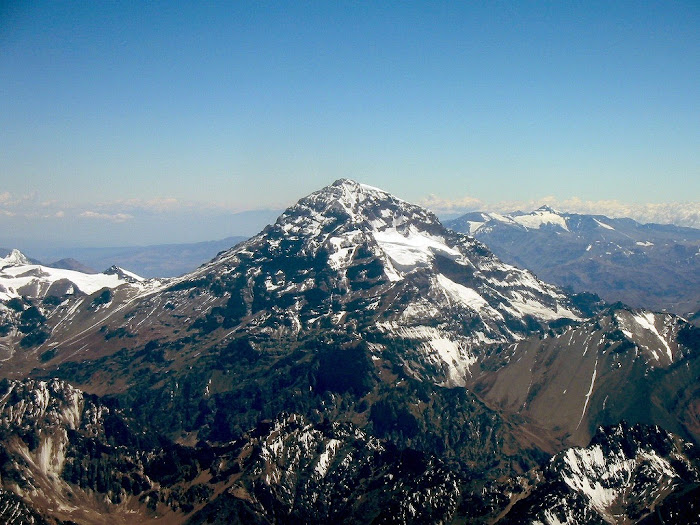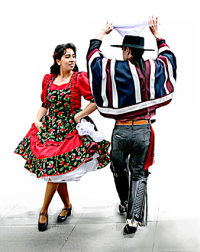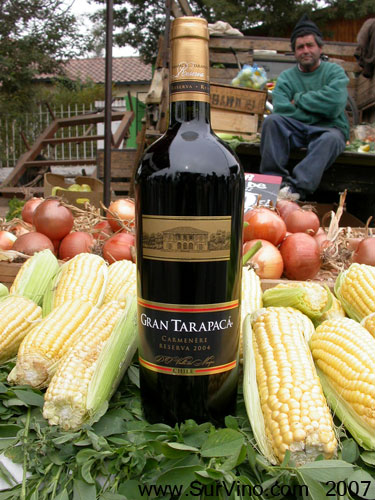Thursday, October 25, 2007
Articulo uno
Wednesday, October 24, 2007
La Cueca y La Musica de Chile
La música para la cueca en 1824 para acompañar el baile. Otras músicas de chile incluyen rock de chile, folklórico, tonada, y waltz. Artistas famosos de chile son los jaivas, víctor jara, y violeta parra. Son famosos de chile rock que se similar a punk rock en los estados unidos.
Chile’s National Dance: The Cueca
The national dance of Chile is called the Cueca. This dance has rich historical roots in both African and Native American cultures. Even though Chileans have been dancing the Cueca for years, it wasn’t declared the official dance of Chile until September, 1979.
The Cueca is a parody of the courtship of a chicken and rooster. The dancers wave handkerchiefs above their heads during the dance. These handkerchiefs can symbolize the feathers of the bird or the rooster’s comb.
Children dance the Cueca. Picture by Gabriel Ortega Berger.
The choreography (movements) of the Cueca consists of circles, moving in semicircles back and forth (known as half moons), and turning towards the partner and then away.
The dance happens in an imaginary circle, with the man in one half, and the woman in the other. It starts with a promenade where the man invites the woman to join him by offering his arm. This is done while instrumental entry music is played. The couples stand facing each other about three meters apart. Before the song begins, the couple claps their hands in rhythm of the music.
Movements and Steps of the Cueca
You can learn the steps of the dance from the following pages. These are in Spanish but have diagrams outlining the movements:
Cueca instructions
Steps of the Cueca
Learning to dance our national dance
Clothing
Those that really know how to dance the Cueca will dress up in traditional chilean clothing when they dance. This is particularly true during the independence day celebrations every September. The men wear a Chilean cowboy hat, shirt, flannel poncho, riding pants, short jacket, riding boots, and spurs. Women wear a flowered dress with an apron. Here is a video of a school’s Cueca competition that shows the traditional clothing the dancers wear:
Thursday, October 18, 2007
Aconcagua
La Agricultura De Chile
Chile es el exporador mas grande de todo el mundo en cumbre. Los exportes meyores son cumbre, oro, plata, madera, papel, vino, pesca, y diferentes frutas tambien. Chile exporta a los estados unidos, china, y japan. Importa a los estados unidos, argentina, y brazil. Los recursos naturales son muy rico asi que la agricultura esta muy bien. Los vinos de chile son muy populares de todo el mundo y personas viajan de todo el mundo a chile para el vino. La agricultura de chile es muy importante para la economica porque la economica de chile es pobre.
Chile’s agriculture and food industry are unique because the country has been blessed with rich natural resources and a diversity of environmental and climatic conditions. These factors, combined with Chile’s location on the Pacific Coast of the southern tip of the American continent, its high phytosanitary and zoo-sanitary standards and the quality of the sector’s human capital, have positioned Chilean agriculture as the main exporter of fresh fruits in the Southern Hemisphere.
Chile also has a flourishing and competitive food and forestry industries. Chilean agro-industry –among other products— processes and exports food products as diverse as canned, dehydrated and frozen fruits and vegetables, juices, fruit pulps, seeds, olive oil, wines, beef, pork, lamb and poultry, as well as a variety of dairy products.
Chile can also be described as a forestry nation. Chilean producers export lumber and processed wood products such as mouldings and packaging material, furniture, fibre-board, particle-board and plywood. Chilean producers also export woodchips, as well as pulp and paper.
Today, Chile’s agribusiness has emerged as one of the country’s most successful export sectors and a large variety of its products can be found in most countries of the world.
This section provides statistical data and detailed information on the evolution of Chilean agriculture. It also directs you to websites of government agencies, Chilean trade associations and international organizations that maintain up to date production and trade data, as well as business information. You will also find research reports and documents of general interest.
Chilean Agriculture
Chile's diverse geography yields itself to many agricultural products. These are sold and used in the country and also make up a large percentage of Chilean exports to other countries.
Lumber and Timber
Chile has vast forested lands in its southern half. These trees provide the source for lumber, wood furniture, and other wood products.
Fishing
Chile's slender shape hugs the Pacific Ocean from Peru in the north to Antarctica in the south. This huge coastline allows for a very productive fishing industry catching everything from salmon to Chilean Sea Bass.
Fruit and Vegetables
Chile's fertile central valley is ideal for growing many types of fruits, vegetables, and grains. Due to a favorable climate and geographic isolation that reduces foreign pests and diseases, Chile is able to have a thriving agriculture industry.
As Chile sits in the southern hemisphere, its growing season allows fruit and vegetable exports to the USA, Canada, and Europe during their winter months.
Leading Chilean Agriculture Products
grapes
apples
pears
onions
wheat
corn
oats
peaches
garlic
asparagus
beans
beef
poultry
wool
fish
timber
Of the total land area of 74.8 million hectares (184 million acres),2.3 million hectares (5.7 million acres) is arable land. Until 1940, Chile was substantially self-sufficient in most basic foodstuffs. Since World War II (1939–45), serious food deficits have developed, adding to the nation's external payments burden.
Agricultural production of major crops in 1999 (in tons) was as follows: sugar (raw), 448,000; wheat, 1,197,000; corn, 624,000; oats, 201,000; barley, 81,000; rapeseed (canola) 72,000; and rice, 61,000.
Agriculture was one of the sectors most adversely affected by the recession of 1982, but it quickly recovered by the mid-1980s. Poor results in the traditional agricultural sector inhibit a more rapid expansion in agriculture. One of the areas of most rapid growth is in fresh fruit, with the production of grapes rising by 235% between 1981 and 1985. The fruit harvest in 1999 (in tons) included grapes, 1,575,000; apples, 1,165,000; peaches and nectarines, 310,000; pears, 350,000; oranges, 185,000; and lemons and limes, 110,000. Avocado production for 1999 was estimated at 82,000 tons, up from 39,000 tons during 1989–91. Most of the avocado orchards are in central Chile, from Region IV to Region VI.
The traditional land system, inherited from colonial times, has retarded maximum use. Chile's first agrarian reform law, passed in 1962 and supplemented by a constitutional reform in 1963, enabled the government to expropriate and subdivide abandoned or poorly cultivated land and compensate the landowner in installments. Another agrarian reform law was passed in 1967 to clarify expropriation and settlement procedures and to permit an increased turnover rate. By the end of the Frei administration in November 1970, some 1,400 agricultural estates, representing3.4 million hectares (8.4 million acres), had been confiscated and converted to asentamientos (agricultural communities).
The pace of expropriation was accelerated by the Allende government, which by 1972 had doubled the previous administration's figure for land acquisitions. By taking over virtually all of the land subject to redistribution under the 1967 reform act, the Allende government effectively transformed the Chilean land tenure system. In addition, agricultural laborers, often led by militants to the left of the Allende government, illegally seized some 2,000 farms. Following the 1973 coup, the military regime returned almost all farms in the last category to their original owners; the expropriated land was redistributed to 45,000 smallholders. In 1978, the land reform law was replaced by new legislation that removed restrictions on the size of holdings
Tuesday, October 16, 2007
el poeta
Llega el invierno. Espléndido dictado me dan las lentas hojas vestidas de silencio y amarillo. Soy un libro de nieve, una espaciosa mano, una pradera, un círculo que espera, pertenezco a la tierra y a su invierno. Creció el rumor del mundo en el follaje, ardió después el trigo constelado por flores rojas como quemaduras, luego llegó el otoño a establecer la escritura del vino: todo pasó, fue cielo pasajero la copa del estío, y se apagó la nube navegante. Yo esperé en el balcón tan enlutado, como ayer con las yedras de mi infancia, que la tierra extendiera sus alas en mi amor deshabitado. Yo supe que la rosa caería y el hueso del durazno transitorio volvería a dormir y a germinar: y me embriagué con la copa del aire hasta que todo el mar se hizo nocturno y el arrebol se convirtió en ceniza. La tierra vive ahora tranquilizando su interrogatorio, extendida la piel de su silencio. Yo vuelvo a ser ahora el taciturno que llegó de lejos envuelto en lluvia fría y en campanas: debo a la muerte pura de la tierra la voluntad de mis gerruinaciones.
Aconcagua

La Montana mas grande de todo el sur
La Cueca

Pablo Neruda

El Poeta Famoso de Chile
El Vino

El vino de chile es fantastico y es una exporta importante
Victor Jara
